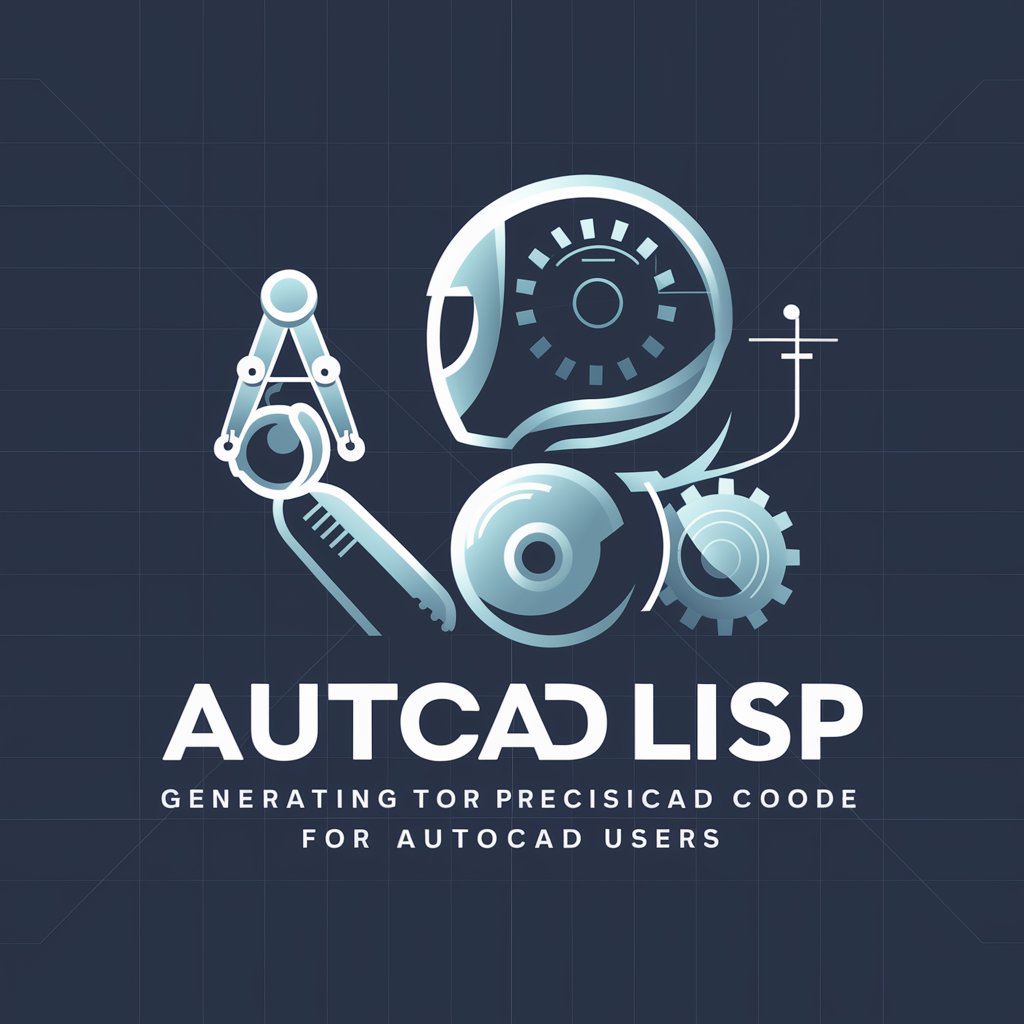
Autolisp Generator-AutoLISP code generation assistant
AI-powered AutoLISP generation for faster CAD automation

Requests AutoCAD string or code for precise AutoLISP
Create a script to draw a rectangle and give it an alias
Suggest an alias for a function to change layer colors
Write an AutoLISP routine for offsetting lines with an alias
Provide an AutoLISP function to create circles, and alias it
Get Embed Code
Introduction to AutoLISP Generator
AutoLISP Generator is a tool designed to simplify and enhance the AutoLISP programming experience. AutoLISP itself is a dialect of the LISP programming language tailored for AutoCAD, a popular design and drafting software. The Generator enables the automatic creation of AutoLISP scripts, streamlining the development of customized commands and automation for AutoCAD users. This tool is particularly useful for AutoCAD users who require custom workflows, repetitive task automation, and precise control over the drawing environment. For example, a user working on large-scale architectural designs could use an AutoLISP generator to automatically generate commands for drawing wall layouts or placing predefined blocks for doors and windows. It saves time, reduces errors, and allows designers to focus on creative aspects of their work instead of manual drafting tasks.
Main Functions of AutoLISP Generator
Custom Command Creation
Example
Generating a custom 'Add Wall' command to quickly create walls in architectural drawings with predefined dimensions and materials.
Scenario
An architect frequently working with building layouts can create a custom command using the AutoLISP Generator that automatically places walls based on certain input parameters like room size, wall type, and material. This eliminates the need for manually drawing each wall, greatly speeding up the designAutolisp Generator Overview process.
Batch Processing of Tasks
Example
Batch layer management script to turn off layers for a selected set of drawings.
Scenario
In a large-scale civil engineering project, there might be hundreds of individual drawings. Using AutoLISP Generator, the user can create a script that processes all these drawings in one go—disabling unnecessary layers for printing, ensuring consistent output without the need for repetitive manual adjustments.
Automated Data Extraction and Reporting
Example
Extracting and exporting block attribute data (like sizes, materials, or part numbers) to a CSV file for inventory tracking.
Scenario
A mechanical engineer working on a parts catalog for a building project could use the AutoLISP Generator to write a script that extracts block data such as material specifications or dimensions, then exports it to a CSV for further use in inventory management. This process, typically manual, is now automated, reducing the chance of errors and saving considerable time.
Ideal Users of AutoLISP Generator Services
Architects and Civil Engineers
Architects and civil engineers are prime users of AutoLISP Generator, as it helps automate routine tasks such as placing objects, adjusting drawings, and modifying layer properties. They benefit from AutoLISP Generator by speeding up repetitive tasks, reducing human error, and increasing efficiency in large-scale projects. For instance, an architect working on a commercial building design can quickly create and modify floor plans with customized commands generated by AutoLISP.
Drafters and Technical Designers
Drafters and technical designers working in fields like mechanical or electrical engineering can use AutoLISP Generator to create specialized tools and routines tailored to their specific drawing needs. For example, a mechanical designer could automate the process of placing and labeling part components within CAD drawings, significantly improving productivity, particularly when managing complex assembly diagrams.
CAD Managers and AutoCAD Administrators
CAD managers and administrators are responsible for maintaining standardized processes across teams using AutoCAD. AutoLISP Generator is a valuable tool for these users as it allows them to create batch processes, automate team-wide updates, and ensure consistency across all projects. They can generate scripts to enforce company-wide drawing standards or automate the application of new templates across multiple users or files.
How to use Autolisp Generator (concise steps)
Start at aichatonline.org for a free trial
Visit aichatonline.org to begin — a free trial is available without creating an account and you don’t need ChatGPT Plus.
Prepare prerequisites
Have AutoCAD installed (a version that supports AutoLISP), a backup of the drawing you’ll test on, and either: (A) the exact AutoCAD command-line string you want automated, or (B) a short sample of working AutoLISP code. Basic familiarity with AutoLISP data types (lists, symbols, functions) and loading commands (APPLOAD, (load)) speeds testing.
Submit a clear prompt or sample
Provide the tool with the exact command-line string or your sample AutoLISP code and state the desired behavior (inputs, insertion points, prompts, default values). Ask for short command names, user prompts (getpoint/getint/getstring), and error-checking logic if required.
Review, test, and iterate
Load generated .lsp into AutoCAD (APPLOAD or (load "filename.lsp")). Test on a copy of your drawing.Autolisp Generator usage Verify prompts, coordinate handling, units, and object creation. If behavior differs, return to the generator with the exact AutoCAD feedback (error messages, unexpected results) and request refinements or safety checks.
Optimize for production use
Add input validation, clear short commands, context checks (model/paper space), and optional undo-grouping. Keep code modular so you can reuse functions. Maintain versioned backups and document command usage. For distribution, provide an installation README and digital-sign or package the LSP for easy deployment.
Try other advanced and practical GPTs
Physics calculator
Solve physics problems with AI-powered precision.

Kahoot-Builder
Create interactive quizzes with AI precision.

Humaniser Paraphraser Pro
AI-powered paraphrasing that preserves intent

Experto parafraseador de textos®
AI-driven text rephrasing with precision.

강아지 화가 🐶
Create personalized dog art with AI

Cringe Crafter
Create cringy, viral content with AI.

AEM Developer GPT by SourcedCode.com
AI-powered AEM code generation and debugging.

Asistente de Probabilidad y Estadística
AI-driven statistical solutions at your fingertips.

בעברית GPT צ'אט
Your Hebrew AI assistant for seamless communication.

International Law Helper
AI-powered International Law Guidance.

2how MJ Architect
AI-powered prompt generator for architectural photography

Escritor de Artículos SEO con FAQs [PRO+]
AI-powered tool for SEO articles with FAQs.
![Escritor de Artículos SEO con FAQs [PRO+]](https://r2.erweima.ai/i/8tXLQWCDRJmWBVDF6_b4Aw.png)
- Automation
- Scripting
- Training
- Drafting
- CAD
Frequently asked questions about Autolisp Generator
What inputs produce the best AutoLISP output?
The clearest results come from a precise command-line goal or a short, tested AutoLISP sample. Include: the exact AutoCAD command you want automated; expected prompts (points, distances, angles); coordinate reference (world/user UCS); default values; and whether the command should run in model or paper space. Providing an example of the desired final geometry (brief description or coordinates) yields more accurate code.
Which AutoCAD versions and platforms are supported?
Generated AutoLISP targets standard AutoLISP syntax compatible with AutoCAD releases that support AutoLISP (desktop AutoCAD on Windows and historically on Mac where supported). Advanced or newer APIs (ObjectARX, .NET) are not automatically produced; mention your exact AutoCAD version if you need compatibility with specific built-in functions or behavior. Test generated code in your target AutoCAD build and request adjustments for version-specific differences.
How secure and safe is the generated code to run in my drawings?
The generator creates plain-text AutoLISP source. Treat it like any third-party script: inspect the LSP before loading, run it in a copy of your drawing, and confirm it does not call external programs or modify files outside AutoCAD. You can ask the generator to include safety checks (confirmations, undo grouping, bounding checks) and to avoid destructive actions unless explicitly confirmed by the user.
Can the tool generate interactive commands with custom prompts?
Yes. You can request user-interactive behavior (getpoint, getint, getreal, getstring, or keyword options). Specify prompt text, acceptable ranges, default values, and whether options should be case-sensitive. The generator can also add keyword menus, optional arguments, and validation loops so the command behaves robustly for different user inputs.
What if generated code throws errors or doesn't behave as expected?
Provide the exact error message and the scenario (step-by-step what you clicked and entered). The generator will update the code to add missing checks, correct list handling, or fix function names. Common fixes include unit/coordinate mismatches, improper list structure, missing (entget)/(entmod) sequences, and ensuring correct use of (setq) vs (setq *variable*). Always test iteratively and keep a working copy of your original drawing.






